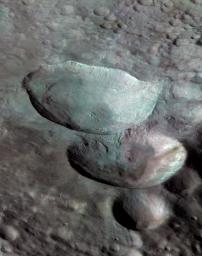Phil is right,
we are now in HAMO2, looking at the north pole for the first time. we have also been looking at the shadowed areas since last! I hadnt realized we had not shown any of these yet! quite amusing that we can see into the shadows in this way. nice camera. i hope to show some more someday soon.
paul
Full Version: LAMO
Well, to be precise we aren't in HAMO2 anymore because, starting from yesterday, Dawn ignited engines and started the depart phase from Vesta...!
I'm looking forward to seeing some whole-frame images during the departure, a different view than we had during the approach.
Phil
Phil
Based on simulated viewer and yesterday's Marc report, engines were ON for more than 24 hours and, as showed in the following plots, Dawn orbit is rapidly changing:
Click to view attachment
Last apoapsis was 776.5 km above Vesta surface, about 63 km above HAMO2 in last days... Total energy is clearly increasing too, however departure phase will last more than a month.
Meanwhile, starting from Phil idea, I made these compositions of last 3 posted images in the "revealing shadows" series:
Click to view attachment Click to view attachment Click to view attachment
(first one is in Oppia quadrangle and latter two inside Marcia quadrangle). Consider that, for shadowed region, besides the different hue I used negative image in order to have an illumination roughly coherent with illuminated part.
Click to view attachment
Last apoapsis was 776.5 km above Vesta surface, about 63 km above HAMO2 in last days... Total energy is clearly increasing too, however departure phase will last more than a month.
Meanwhile, starting from Phil idea, I made these compositions of last 3 posted images in the "revealing shadows" series:
Click to view attachment Click to view attachment Click to view attachment
(first one is in Oppia quadrangle and latter two inside Marcia quadrangle). Consider that, for shadowed region, besides the different hue I used negative image in order to have an illumination roughly coherent with illuminated part.
Further update on escape maneuver:
Click to view attachment
Dawn is rapidly receding from HAMO orbit thanks to uninterrupted engine thrust; based on simulator figures, during last orbit there was an increase of apoapsis/periapsis heights of 57.9/59.3 km (a rising rate greather than 80 km/day); total energy/mass increased by 2.1 kJ/Kg in 4 days.
Added: same processing for the 5th image of "revealing shadows" series, in the Floronia quadrangle:
Click to view attachment
Click to view attachment
Dawn is rapidly receding from HAMO orbit thanks to uninterrupted engine thrust; based on simulator figures, during last orbit there was an increase of apoapsis/periapsis heights of 57.9/59.3 km (a rising rate greather than 80 km/day); total energy/mass increased by 2.1 kJ/Kg in 4 days.
Added: same processing for the 5th image of "revealing shadows" series, in the Floronia quadrangle:
Click to view attachment
Further update:
Click to view attachment
The first engine stop, on July 31, lasted less than 15 hours and, after this, energy increase was very regular.
Click to view attachment
The first engine stop, on July 31, lasted less than 15 hours and, after this, energy increase was very regular.
Click to view attachment
The second engine stop, on Aug 2-4, was longer (between 30 and 45 hours) and, probably, was used to map the northern emisphere; in fact Dawn flied twice above North Pole at an estimated height of 1450 km (considering Vesta shape).
Herebelow last two "revealing shadow" processed images, from Caparronia and Floronia quadrangles, respectively:
Click to view attachment Click to view attachment
The second engine stop, on Aug 2-4, was longer (between 30 and 45 hours) and, probably, was used to map the northern emisphere; in fact Dawn flied twice above North Pole at an estimated height of 1450 km (considering Vesta shape).
Herebelow last two "revealing shadow" processed images, from Caparronia and Floronia quadrangles, respectively:
Click to view attachment Click to view attachment
http://pds-smallbodies.astro.umd.edu/data_...ase_sched.shtml
According to this data release schedule, we should get raw approach and HAMO data soon at PDS. But the arguments over coordinate systems may delay this a bit.
Phil
According to this data release schedule, we should get raw approach and HAMO data soon at PDS. But the arguments over coordinate systems may delay this a bit.
Phil
More reaction wheel problems: 
http://www.nasa.gov/mission_pages/dawn/new...wn20120813.html
http://www.nasa.gov/mission_pages/dawn/new...wn20120813.html
QUOTE
During a planned communications pass on Aug. 9, the team learned that the reaction wheel had been powered off. Telemetry data from the spacecraft suggest the wheel developed excessive friction, similar to the experience with another Dawn reaction wheel in June 2010. The Dawn team demonstrated during the cruise to Vesta in 2011 that, if necessary, they could complete the cruise to Ceres without the use of reaction wheels.
Yes I got that from this news source.
Now that they are optimistic about getting over to Ceres without reaction wheels, I cant shrug off the thought that the pointing for instruments and camera will be affected.
Anyhow since that Dawn is in the departure phase, perhaps it is time to start a 'Cruising to Ceres' thread. =)
Now that they are optimistic about getting over to Ceres without reaction wheels, I cant shrug off the thought that the pointing for instruments and camera will be affected.
Anyhow since that Dawn is in the departure phase, perhaps it is time to start a 'Cruising to Ceres' thread. =)
Are there only two wheels?
Two fully functioning left of the 4 functioning at launch.
There are some new captioned releases here:
http://dawn.jpl.nasa.gov/multimedia/vesta_dawn_gallery.asp
... and I can't seem to see that they relate to any new paper or conference release.
http://dawn.jpl.nasa.gov/multimedia/vesta_dawn_gallery.asp
... and I can't seem to see that they relate to any new paper or conference release.
This is a "lo-fi" version of our main content. To view the full version with more information, formatting and images, please click here.
